How to Study Your Bible, Part 3
Please see Part 1 and Part 2 for the rest of the Study Notes.
Click here to download PDF: How to Study the Bible Part Handout
Bible Study Step #3 – Investigate the Text for Clarity
This step is a bridge between observation and interpretation. Remember that observation is seeing what the text says. Interpretation is discovering what the text means by what it says. Investigation helps us to get from what the text says to what it means.
As we observed at the end of our last lesson that, after prayerfully reading the text in context and observing what the text says, we may still have unanswered questions. Many things will be clear, but perhaps a few things are still hazy. We may need to do some detailed investigation of the text. Where do we go to bring clarity to our understanding of what the text says?
At the end of our last lesson we made a list of questions we had about the text. Some of these questions can relate to:
- Meanings of words
- Difficult phrases or sayings
- Historical or cultural background
- Meaning of figures of speech
- How the passage relates to other scriptures
How do we research the answers to our unanswered questions?
A. Compare Bible Translations
When it comes to understanding difficult or unfamiliar words and phrases, it sometimes helps to read the text in a different translation.
What is a Bible translation?
A translation is the result of transferring the text of the Bible from its original language (Hebrew, Aramaic, or Greek) into another language—in our case, English. The Bible was written a long time ago in ancient languages. The Old Testament was mainly written in Hebrew with a small portion composed in Aramaic. Aramaic is a language similar to Hebrew. The New Testament was originally written in the common Greek of the day. Whenever the Bible is expressed in a language other than these, it is a translation. Sometimes we call these translations, “versions” of the Bible.[1]
The King James Version (KJV), English Standard Version (ESV), New International Version (NIV), New American Standard Bible (NASB), Christian Standard Bible (CSB), New Living Translation (NLT) and Legacy Standard Bible (LSB) are popular examples of Bible versions. I usually preach from the New King James Version (NKJV) of the Bible.
Many times, there are a variety of ways that words and phrases can be translated from one language into another. There is not always a one-to-one correspondence between words in different languages. So, comparing different translations may shed some light on the meaning of these words or phrases.
Why do English translations sometimes read differently?
Languages often do not correspond one-to-one because words in both languages (the original and the translation) can have a variety of meanings and uses. Also, translators often have to decide whether they will make the translation closer to the original and possibly harder to read in the translation, or whether they will make it easier to read in the translation but possibly less literally close to the original said. Therefore, some translations are more literal, and others are more dynamic. Translations fall across a spectrum from Formal Equivalence (more word for word) through Functional Equivalence (more dynamic) to Paraphrase (more thought by thought).
Here is a comparison of the literalness of some popular translations[2]:
FORMAL EQUIVALENCE | FUNCTIONAL EQUIVALENCE | PARAPHRASED | ||||||||||
Young’s | NASB | Amp | KJV | NRSV | NIV | NCV |
| GNT | TLB | Msg | ||
NASB = New American Standard | NRSV = New Revised Std Version | Phillips = J B Phillips Paraphrase | ||||||||||
Where does Bible you use fall in this spectrum?
I generally use the New King James Version in my preaching or teaching. But I also often consult other translations such as the NASB, ESV, NIV, and CSB. Many of these translations rely more heavily on different manuscript traditions than the KJV and will favor other textual variants that the NKJV puts into the footnotes.
What is the advantage of reading from other translations or paraphrases?
It can help in seeing the richer meaning of some words and phrases.
What are the hazards of using some translations?
Some translations and paraphrases are highly interpretive and may reflect the translators’ biases over the original author’s meaning.
Tool: Parallel Bible
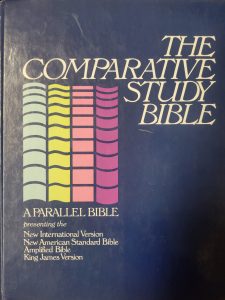
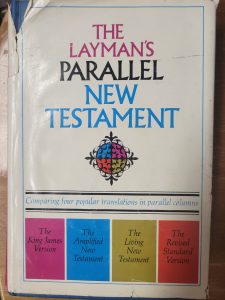
You may compare translations of a passage by opening up all the different translations you have on hand and noting the similarities and differences. Parallel Bibles are a time-saving resource that have multiple translations side-by-side for easy comparison.
If you have access to the internet, there are several sites where you can compare translations. A good example is https://thebible.org. Below is a screenshot of their Parallel Plus comparison of Psalm 119:1-3.

Compare and Contrast different translations of Psalm 119:1-3:
What differences do you notice in Psalm 119:1?
Most translate the first word as “Blessed” (NKJV, ESV. NASB, NIV), but the NLT translates it as “Joyful”, and the CSB translates it as “How happy”. The word that the NKJV translates as “unfiled”, others translate as “blameless” or “integrity”. Most translate the verb in the second line as “walk” but the NLT translates it as “follow”. In that same phrase, the preposition “in” (NKJV, ESV, NASB) can also be translated “according to” (CSB, NIV). Two translations render the word “law” as “instruction(s)” (NLT, CSB).
These differences may help us to understand the nuanced meanings of these words. We could repeat the process with the rest of the verses. For instance,
What differences do you notice in Psalm 119:2 & 3?
In Psalm 119:2, we also notice the different translations of “Blessed” as “Joyful” or “Happy”. The verb in line one is either “keep” (NKJV, ESV, CSB, NIV), “comply with” (NASB), or “obey” (NLT). The last word of line one is either “testimonies” (NKJV, ESV, NASB), “laws” (NLT), “decrees” (CSB), or “statutes”. In the NLT, “seek” is rendered “search for”. The phrase “whole heart” (NKJV, ESV) can also be “all their heart” (NASB, NLT, CSB, NIV).
In Psalm 119:3, “do no iniquity” (NKJV) is also rendered as “do no wrong” (ESV, NIV), “do no injustices” (NASB), “compromise with evil” (NLT), or “do nothing wrong” (CSB). They “walk in His ways” (NKJV, ESV, NASB, CSB) could also be rendered “walk only in his paths” (NLT) or “follow his ways” (NIV).
I encourage you to take the time this week to compare the rest of the verses in Psalm 119:1-8.
Tool: Amplified Bible.
Another translation that can be helpful in word and phrase meanings is the Amplified Bible. Look at how it translates Psalm 119:1-3,
1 ALEPH. How blessed and favored by God are those whose way is blameless [those with personal integrity, the upright, the guileless], Who walk in the law [and who are guided by the precepts and revealed will] of the LORD.
2 Blessed and favored by God are those who keep His testimonies, And who [consistently] seek Him and long for Him with all their heart.
3 They do no unrighteousness; They walk in His ways.
(Psalm 119:1-3 AMP).
What do you notice about the character and design of this translation?
The Amplified Bible will often give alternative translations, additions, or clarifications of words in brackets. This obviously sometimes makes reading the Amplified Bible cumbersome. But using it to see additional or alternate meanings for words can be very helpful. Again, this Bible translation can be found online at several good Bible sites like, Blue Letter Bible, Bible Gateway, Studylight, The Parallel Bible, and YouVersion. Some of these also have apps for use on your mobile device.
This leads us to the next area of investigation:
B. Word Studies
Why is it important to study the meaning of words in the Bible?
Words are the building blocks of thought. Since God has communicated with us verbally in the written scriptures, it follows that a proper understanding of the meaning of individual words is important for a full understanding of the Bible. As we’ve seen, comparing translations may help when we have questions about the meaning or use of certain words. But of course, it’s not only the meaning of the English word that is important, but the meaning of word in the original language. To find this meaning, some words may require additional investigation.
First, it is especially important to remember that words function in a context. This is why we took time to observe the context of the passage before we begin to interpret it. We must also keep the context in mind as we study the biblical words and how they are used.
How does the context change the meaning of a word?
Example: Consider the sentence, Jim is green. What does green mean?
It could mean a number of things. Context alone will tell. What does green mean in these cases?
- Jim is green. He spilled the paint all over himself.
- Jim is green. He’s been bitten by the green-eyed monster of jealousy.
- Jim is a green. He has no clue what he is doing because he’s never worked this kind of job before.
- Jim is green. He’s had an upset stomach all week.
- Jim is green. He recycles everything and promotes renewable energy.
When words can have such diverse meanings, how do we determine the meaning of such a word? Several factors may be considered[3]. You can ask questions like:
- Does the author give his own definition of the word in the context? (cf. Heb. 5:14; 2 Tim. 3:17).
- Is the word defined by a qualifying phrase or editorial comment? (cf. John 2:19, 21; 7:37-39; Eph. 1:7).
- Does the grammatical context shed light on the meaning? In Matthew 5:13 we know that the verb “loses … favor” (moraino, μωραίνω, G3471) means “to be tasteless” and not “to become foolish” (as in Rom. 1:22; 1 Cor. 1:20), because of its grammatical relation to “salt” in the text.
- Does the subject matter require a certain meaning? (cf. 2 Corinthians 5:1 where “house” [οἰκία, οἰκία g3614) refers to our “physical body” not our domicile; Rom. 8:5-8 where “flesh” probably does not refer to our physical body because of the way it is contrasted with “Spirit”).
- Is there structural parallelism that helps? (cf. Psalm 119:2, “those who keep His testimonies” has parallels “Who seek Him with the whole heart.” Ask, “Is it synomymous, antithetic, or synthetic parallelism?” See Bible Study Step #1 for definitions of these).
- Are there cross references that give insight? (cf. “Blessed” in Psalm 119:1,2 cross references to Psalm 1:1-3). A cross-reference Bible or tools like Treasury of Scripture Knowledge (TSK) on the Blue Letter Bible are helpful here.
- How is the word is used in the same chapter, book, and other parts of the Bible? (The most important usage is the immediate context, then a remote context in the same book, a context by the same author or in the same genre, finally, other remote contexts in the Bible. Warning: a word does not always have the same meaning everywhere it occurs in Scripture, even in the same book).
Example: The Apostle John uses the word “world” in his Gospel in many different ways. It can mean: the entire universe, John 1:10; the physical earth, John 13:1; the evil world system under Satan, John 12:31; and the world of humanity, John 3:16.
Look at John 3:17, “For God did not send His Son into the world to condemn the world, but that the world through Him might be saved.”
What does the first “world” mean? It refers to the world into which Christ came: the physical world or world of humanity.
Does the second “world” mean the same thing? If so, then does that mean that, because Christ has come, God will not condemn any in the world? Does that mean everyone in the world will be saved?
What does the third “world” mean? Again, does it mean all people in the world? Or does it mean the world of only those who believe and are saved? Or does it mean the world of those who potentially will be saved?
Examining the context in John 3 and the rest of John’s Gospel and epistles can be helpful in determining the meaning of “world”.
As you can see, investigation like this connects with interpretation of the passage, because sometimes the interpretation of a verse may hinge on the meaning of a word. If you are interested in this subject, you can study it further using concordance, cross-reference, or commentary tools.
Let’s do a word study from Psalm 119.
What words in Psalm 119:1-8 did we have questions about from our observations? (see Bible Study Step #2.E, pick one)
Examples:
What does it mean by “blessed”? (Ps. 119:1)
What is “undefiled”? (Ps. 119:2)
Is the difference between the synonyms for “law” important? (Psalm 119)
What is iniquity? (Ps. 119:3)
What is meant by the term “the undefiled” (Psalm 119:1)?
From the context:
We have seen parallelism that explains and clarifies “the undefiled” as those who “walk in the law of the Lord” (Ps. 119:1), “keep (God’s) testimonies” (Ps. 119:2), “seek Him with the whole heart” (Ps. 119:2) , and “do no iniquity” (Ps. 119:3). Therefore, it has the note of obedience, diligence, and purity.
From Parallel translations:
We just saw in our parallel translation study that it is translated either undefiled, blameless, or people of integrity. The Amplified Bible expands it to those with personal integrity, the upright, the guileless.
From the concordance:
A tool that is helpful in word studies is a concordance.[4] A concordance is an alphabetical index of words used in the Bible and the main Bible references where the word occurs. Some study Bibles have a limited concordance as an appendix.
Does the concordance give definitions or meanings of the word?
The concordance shows that this adjective is used 91 times in 85 verses, variously translated as without blemish (44x), perfect (18x), upright (8x), without spot (6x), uprightly (4x), whole (4x), sincerely (2x), complete (1x), full (1x), and undefiled (1x). It’s root is a verb (tāmam, תָּמַם H8552) that means to complete, finish, perfect, or make clean.
Where else is this word used in Psalms?
Psalm 119:80
Psalm 15:2
Psalm 19:7
The concordance shows that this word is used again in the same chapter in Psalm 119:80, “Let my heart be blameless regarding Your statutes, That I may not be ashamed.” Psalm 15 asks about those who may abide in the LORD’s tabernacle, answering, “He who walks uprightly, And works righteousness, And speaks the truth in his heart” (Psalm 15:2). Psalm 19 uses this word to describe God’s Law, “The law of the LORD is perfect, converting the soul; The testimony of the LORD is sure, making wise the simple.” (Psalm 19:7).
It is used to describe Noah as “perfect” (Gen. 6:9). God commanded Abraham to “walk before Me and be blameless” (Gen. 17:1). The Passover lamb was to be “without blemish” (Exo. 12:5). Moses commanded Israel “You shall be blameless before the LORD your God.” (Deut. 18:13).
Some advanced Bible students may want to consult a Hebrew lexicon (cf. BDB).[5] A Bible lexicon is a specialized dictionary that provides detailed information about the meaning, usage, and historical context of words in the original languages of the Bible. There are other, even more in-depth theological dictionary tools that an advanced student may consult for insight (cf. Vines, TWOT or TDOT)[6].
Thus, from our word study we have a better understanding of the word “undefiled”. You may wish to do a similar word study on other words in the passage that are still unclear.
Next, we can …
C. Study Phrases
Words combine to make phrases or smaller elements of sentences and verses. The online Bibles are helpful in studying phrases. Most of them have a search tool where you can type in a word or phrase and see if there are other places in the Bible that have that same phrase or combination of words.
Example:
Are there any other verses in the Bible with the phrase “uprightness of heart”?
If we search for this phrase in the NKJV on BLB, we get these results for the exact phrase:
6 And Solomon said: “You have shown great mercy to Your servant David my father, because he walked before You in truth, in righteousness, and in uprightness of heart with You; You have continued this great kindness for him, and You have given him a son to sit on his throne, as it is this day. (1 Kings 3:6)
7 I will praise You with uprightness of heart, When I learn Your righteous judgments. (Psalm 119:7)
We also see that it gives three verses that have the same words, just not the exact phrase:
5 “It is not because of your righteousness or the uprightness of your heart that you go in to possess their land, but because of the wickedness of these nations that the LORD your God drives them out from before you, and that He may fulfill the word which the LORD swore to your fathers, to Abraham, Isaac, and Jacob. (Deut. 9:5)
4 “Now if you walk before Me as your father David walked, in integrity of heart and in uprightness, to do according to all that I have commanded you, and if you keep My statutes and My judgments, (1 Kings 9:4)
17 “I know also, my God, that You test the heart and have pleasure in uprightness. As for me, in the uprightness of my heart I have willingly offered all these things; and now with joy I have seen Your people, who are present here to offer willingly to You. (1 Chr. 29:17)
What do we learn about “uprightness of heart” from these verses?
It was not because the Israelites had any “uprightness of [their] heart” that God allowed them to possess the land. It was because of His promise. “Uprightness of heart” is related to integrity and obedience to God’s commands. God tests and knows our hearts. He desires uprightness.
Sometimes researching a similar phrase will shed light on its meaning.
Try searching for the phrase “upright in heart”. What does it show?
God saves the “upright in heart.”
The wicked oppose the “upr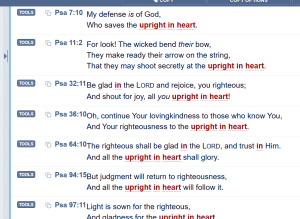 ight in heart.”
ight in heart.”
The “upright in heart” have gladness and joy in the Lord.
The “upright in heart” know God, His love, and righteousness.
The “upright in heart” will trust in the Lord, receive His justice, and truth (light).
Another tool for clarifying words, phrases, verses, and passages is …
D. Cross-References
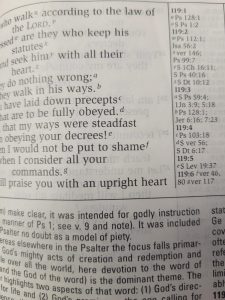
Many study Bibles have cross-references to the verse or to phrases within verses. These are other places in the scripture that might say something similar or something that relates to the subject of the verse or passage.
This image shows the page containing Psalm 119:1-8 from the 1997 edition of the MacArthur Study Bible. Notice the cross-references and notes are in the center column. For instance, for the phrase “whole heart” (Ps. 119:2), it gives cross references of Deut. 6:5; 10:12; 11:13; 13:3.
What do these verses show us about the “whole heart”?
To love, fear, and serve the Lord with our whole heart.
Most study bibles have cross-references either in the margins, center, or in the notes at the bottom of the page.
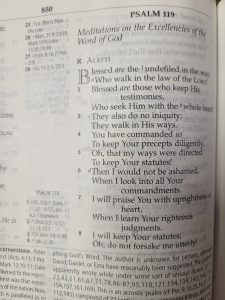
The 1995 NIV Study Bible references Deuteronomy 10:12 for the phrase “all their heart”. The “S” before the reference (meaning “See”) indicates that Dt. 10:12 is the head of a chain of references.
Another popular Study Bible based entirely on cross references is the Thompson Chain-Reference Bible. It groups and numbers cross-references by topics. The chain system allows you to take one verse and “chain” related verses through the whole of Scripture.
These numbered topics have lists of cross-references in the index in the back of the Bible.
You can find a useable version of the Thompson Chain-Reference topical concordance at: https://www.studylight.org/concordances/eng/tcr/b.html?pn=2&.
Or you can download a PDF version of it at https://archive.org/download/ThompsonChainReferenceBible/Thompson%20Chain%20Reference%20Bible.pdf.
You also can download Young’s Analytical Concordance at https://archive.org/download/analyticalconcor0000youn_j4x7/analyticalconcor0000youn_j4x7.pdf.
One of the easiest online tools for cross-references is the Treasury of Scripture Knowledge. This tool is integrated into the Blue Letter Bible. It shows cross references either by the verse or by phrases within the verse.
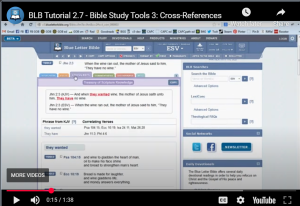
What cross-references does TSK show for Psalm 119:7?
The TSK references the whole phrase “I will praise thee with uprightness of heart”. So some of the references speak about “praise” and others about “uprightness of heart”. Psalm 9:1 and 86:12 speak about praise with the whole heart. 1 Chronicles 29 shows David’s praise to God for the privilege of preparing to build the temple of the Lord in Jerusalem. 1 Chronicles 29:17 uses the phrase “uprightness of heart”.
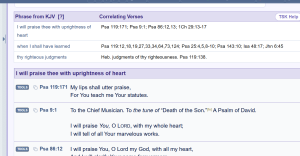
Click here to download PDF: How to Study the Bible Part Handout
————————————————————————————————————-
[1] For more information about Bible Translations, see What Is a Translation? (Version) by Don Stewart, at https://www.blueletterbible.org/Comm/stewart_don/faq/bible-translations/question1-what-is-a-translation.cfm.
[2] For an explanation and comparison of different translations, see Jacob Edson, Complete Guide to Bible Versions: Comparison, History, and Philosophy of Top Bible Translations [Updated 2025], https://www.biblegateway.com/learn/bible-101/bible-versions-guide/.
[3] Sam Storms, How to do a Word Study, https://www.samstorms.org/all-articles/post/how-to-do-a-word-study.
[4] A comprehensive concordance is Strong’s Concordance. Each Hebrew/Aramaic/Greek word is numbered, making it easy to reference. Strong’s includes word definitions based on Bible usage. The Blue Letter Bible incorporates this tool online: https://www.blueletterbible.org/resources/lexical/strongs-definitions.cfm.
[5] The most used Hebrew Lexicon is the Brown-Driver-Briggs-Gesenius Hebrew-Aramaic Lexicon. Blue Letter Bible (BLB) has this tool online: https://www.blueletterbible.org/resources/lexical/bdb.cfm. For the New Testament, BLB also has Thayer’ Greek Lexicon online: https://www.blueletterbible.org/resources/lexical/thayers.cfm.
[6] More comprehensive treatments of Hebrew words are found in Theological Wordbook of the Old Testament (TWOT) and Theological Dictionary of the Old Testament (TDOT, 17 volumes). These tools can be found at TWOT: https://archive.org/details/theologicalwordb0000unse_v6z7; TDOT: https://archive.org/details/theological-dictionary-of-the-old-testament/Theological%20Dictionary%20of%20the%20Old%20Testament%20-%2001/.
For the New Testament, Vine’s Expository Dictionary of NT Words offers a deeper study of biblical words used in the English language. English entries are mapped to each applicable Greek root according to the Strong’s reference numbers, and include biblical usage, main occurrences in the Bible, English transliteration, and definitions. Find it incorporated in BLB: https://www.blueletterbible.org/resources/lexical/vines.cfm.





